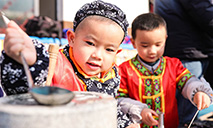Hope high for Cambodia's growth as RCEP, FTA with China to enter into force
PHNOM PENH, Dec. 31 (Xinhua) -- Officials and experts said Cambodia has pinned high hope on the Regional Comprehensive Economic Partnership (RCEP) and the Cambodia-China Free Trade Agreement (CCFTA) to boost its economic growth in the post-COVID-19 pandemic era.
The two free trade deals are due to enter into force on Jan. 1, 2022.
RCEP is a mega trade pact between 10 ASEAN member states and its FTA partners, namely China, Japan, South Korea, Australia and New Zealand.
The Association of Southeast Asian Nations (ASEAN) groups Brunei, Cambodia, Indonesia, Laos, Malaysia, Myanmar, the Philippines, Singapore, Thailand and Vietnam.
RCEP will eliminate as much as 90 percent of the tariffs on goods traded between its signatories over the next 20 years, while the CCFTA will bring the proportion of zero-tariff products in the goods traded between Cambodia and China to more than 90 percent for both countries.
Cambodian Ministry of Commerce's undersecretary of state and spokesman Penn Sovicheat said the two free trade deals will boost Cambodia's exports and attract more foreign investment to the kingdom.
"For Cambodia, both RCEP and CCFTA will give Cambodia a great market access to China and will also push Cambodia to participate more in the markets of other RCEP member countries," he told Xinhua.
Covering a region with a combined gross domestic product (GDP) of 26.2 trillion U.S. dollars, or about 30 percent of global GDP, the RCEP agreement is an unprecedented, modern, comprehensive, high-quality and reciprocal mega-regional trading arrangement that accommodates the broadest possible interests, conditions and priorities of different countries.
Asian Development Bank (ADB) acting-country director for Cambodia Anthony Gill said Cambodia will benefit from both agreements, saying that they will help expand market access and attract more investment to Cambodia.
"The RCEP region is at the center of global economy, so it will help boost economic growth of ASEAN member states, including Cambodia," he told Xinhua.
Gill said the recent rapid growth in exports of agricultural and other higher-value manufacturing products besides garments, travel goods and footwear (GTF) has shown that Cambodia can diversify away from its traditional focus on production and export of the GTF.
"Being part of the trade agreements would provide more market opportunities for Cambodia to expand agriculture production, agro-processing for exports, and non-GTF manufacturing," he said. "It also offers opportunities to further promote the tourism sector to the FTA partners, i.e. China, Japan, South Korea, Australia and New Zealand."
Enjoy Ho, deputy chairman of the Garment Manufacturers Association in Cambodia, said the two deals would bring about better development for Cambodia's textile and garment industry and added that with tariffs reduced or eliminated, cost for production would be cheaper.
"I think there will be more Chinese-funded enterprises investing in Cambodia, which will enrich our product structure," he told Xinhua. "When the cost is reduced, our competitiveness and ability to take orders will be better."
Kin Phea, director-general of the International Relations Institute at the Royal Academy of Cambodia, said RCEP and Cambodia-China FTA are very beneficial for Cambodia.
"It will be a driving force to accelerate trade volume and competitive advantage for Cambodia's foreign direct investment and will help rebuild Cambodia's economy during the post-COVID-19 era," he told Xinhua.
Cambodia's Economy and Finance Minister Aun Pornmoniroth said the country's economic growth is projected at 4.8 percent in 2022, making the GDP value rise to 30.5 billion dollars.
The kingdom's per capita GDP is forecast to increase to 1,842 dollars in 2022, up from 1,730 dollars in 2021, he told parliament in late November, adding that the inflation is estimated to drop to 2.8 percent in 2022 from 3.4 percent in 2021.
Gill said the ADB projected the country's growth to rise to 5.5 percent in 2022 thanks to the noticeable progress of the COVID-19 vaccination rollout.
"The government has also taken steps to mitigate the pandemic's economic and social impacts. Those measures included free COVID-19 vaccines and treatment, cash transfers to poor households, economic stimulus, and loan restructuring programs," he said.
"To increase people's wellbeing and sustain growth, the government will need to continue strengthening its social protection systems and improve the quality of healthcare and education," Gill added.
Photos
Related Stories
- China ready to implement RCEP agreement: official
- RCEP to promote cross-border e-commerce, narrow development gap: company CEO in Cambodia
- Vietnam pins high hope on RCEP for speeding up economic recovery amid pandemic
- RCEP new impetus for regional, global growth: Cambodian officials, experts
- Interview: RCEP to make Southeast Asia flourish, bloom again: Malaysian veteran politician
Copyright © 2021 People's Daily Online. All Rights Reserved.










